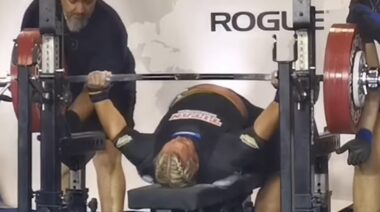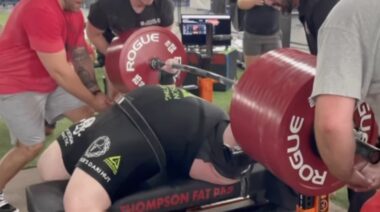For better or worse, the bench press is the ubiquitous measure of strength. Think about it, when was the last time someone asked you how much you squat? The bench press is also typically one of the first movements a new lifer will attempt during their maiden voyage into the weight room. The relentless pursuit of trying to out-bench your buddies starts quickly thereafter.
If that sounds familiar, you have probably read your fair share of bench press articles. Most of them repeat the same messages—work on your form, overload partial range of motion, build up your triceps, get strong overhead, and build a big back. While most of those tips are good advice, I think we can do better.
You might not agree with all of the ideas I present here, and that’s okay. Just keep an open mind. If you take at least one piece of advice from this article and implement it in your training, I think you have some big gains ahead.
Related: The Best Chest Workouts for Muscle Mass, Strength, and More
Bench Press Every Day You’re in the Gym
“If it’s important do it every day, if it’s not important don’t do it at all.”
If improving your bench press is important, start doing it more frequently. Depending on who you ask, that might be unorthodox advice. I feel you should bench press as frequently as you can. Once a week likely won’t cut it, but I’m not necessarily saying you need to bench seven days a week, either.
The first question is, how many days per week can you actually dedicate to the gym? There is no correct answer here. More is not necessarily better. Be honest with yourself. Obviously, if you are currently training three days per week and that’s all you can do, don’t try and force six.
The second question is, how many times per week do you bench press currently? If International Chest Day is the only time you are on the bench, start small. Add extra bench sessions one day at a time, until you work up to your desired frequency.
Increased training frequency is beneficial for a few different reasons. Arguably, the biggest benefit is simply a greater opportunity to practice. Yes, I’m talking about practice (paging Allen Iverson). Strength is a skill, and like any skill, you get better with additional practice.
Make sure you stay consistent with mobility work, and warm up properly before every bench session. Increasing training frequency is not the time to get lazy with the little details!
Skip Direct Shoulder Training
When I say, “skip direct shoulder training”, really what I mean is don’t overhead press. It’s not the missing link to a huge bench.
I like the overhead press. I really do. The problem is, you can only do a limited amount of pressing, both from a recovery and a joint health standpoint. If your goal is to get a huge bench, you would be better off doing more pressing that resembles the bench press. Specificity is key here.
In order to increase your bench press frequency, we need to make a few adjustments. Unfortunately, that means overhead work needs to be taken out or drastically limited. I recommend looking at shoulder work as prehab. Focus on shoulder health—face pulls, band pull-aparts, etc.
Ditch the Dumbbell Work
Dumbbells are great, but like I said above, specificity is king. If you want to maximize the bang for your buck from your workouts, prioritize barbells for assistance work.
Somewhere along the way, people got it in their heads that it was against the rules to do two barbell movements back to back. You start out with a barbell movement and move over to the dumbbell rack for assistance work. Once an idea gets in circulation, it can be hard to make it go away.
What I propose is a different strategy. Pick assistance exercises that more closely resemble the bench press. So instead of dumbbell presses, think close grip bench press, Spoto press, floor press, pin press, board press, incline barbell press, etc.
Following this advice, bench workouts would now look like this:
- Bench press
- CGBP or Spoto press or floor press, etc.
- Back, arms, rear delts
Pause Every Rep
This might seem counterintuitive. Pausing every rep will most likely decrease your bench numbers, at least at first. But in the long run, it will lead to greater gains. Let me explain.
Most raw lifters fail on their chest or a couple inches above. It’s common for lifters to lose tightness and control of the bar during the last couple inches of the eccentric part of the lift. This causes the bar to accelerate at the bottom, which leads to a lack of stability on the chest. Pausing every rep will not only help build stability, it can also improve reversal strength off the chest. If you are weak in a position, it makes sense to spend more time there.
If you are a powerlifter (or plan to be) this is really non-negotiable. The pause is required in competition, so it makes sense to practice how you play.
Most importantly, even if you are not a competitive powerlifter, a paused bench press is still legitimate. There is a reason powerlifting federations require the bar be motionless (pause). It helps standardize the movement. There is a wide range of “touch and go” bench technique, from nice and controlled, to bouncing off the sternum like a beach ball. Nothing is more impressive than hitting a huge PR with picture-perfect form that would pass in a meet. When you do this, the lift doesn’t need an asterisk next to it.
Be Willing to Change Your Form
Last but not least, form. Nothing will make as big of a difference in your bench press strength than dialing in your form. Some lifters can add 20-40lbs on their bench in literally 10 minutes, just by improving technique.
I’m sure you know how to bench press to some extent. The bench is one of the first fundamental lifts you learn after stepping foot inside a gym. However, very few lifters outside of elite powerlifters will understand all the variables and intricacies involved in a proper bench press.
If the first thing you think about when starting a bench press is grabbing the bar, you have already started down the wrong path. First, you need to get your body in a good position. A proper set up will absolutely add pounds to the bar.
The most important point to consider during the setup process is scapular retraction (squeeze your shoulder blades together) and depression (push your lats toward your waist). To accomplish scapular retraction, you will need to arch your back while retracting your shoulder blades together like you would at the top of a barbell row. Think about trying to hold a pencil in your upper back. Once you are retracted, you want to “lock” your lats into place. This is not only the most efficient way to bench press, it’s also the safest.
A powerlifting setup on the bench press isn’t just the most efficient, it’s also the safest.
The “arched” bench press puts the shoulder joint in a more favorable and healthy position, as well as shortens the range of motion. A shorter range of motion creates a more efficient press, especially for longer-armed benchers. Get your shoulders in the right position, and keep them there throughout the entire movement.
Next, we need to look at grip position. Where you grip the bar is going to largely depend on personal preference and limb length. Longer-armed people will require a wider grip. Generally speaking, you want to find a grip position that allows your forearms to remain vertical throughout the entire lift. Keep in mind, the wider you grip the bar, the shorter the range of motion. Most people will be able to bench more weight with a wider grip as long as it’s within reason.
Ok, so you are set up properly and are ready to start. Now what?
The first thing to do is create tension on the bar. The cues “break the bar” or “pull the bar apart” can be helpful to keep in mind.
Elbow position is a big aspect of the bench press where people often need some work. A “bodybuilding bench press” involves flaring the elbows throughout the entire range of motion. Keeping your elbows out wide may provide the greatest stimulus to the chest, but it’s not the best or safest way to bench the most amount of weight. For maximum performance, tuck your elbows on the way down and don’t let them flare out until the bar is about halfway up.
You have to be willing to change everything about your bench—back position, how you grip the bar, etc. Do what is best for the long-term growth of your bench, not how you can bench the most amount of weight today.
Want to know how you stack up to the pros?






